Hi all,
So I've been in this hobby about a year and within that time I've had:
I wanted to Share with people the knowledge and tips I've learnt along the way across fixing and restoring the machines from all the different brands of machines I've owned.
Purchasing a used machine:
The forum has a for sale section, its a good place to find machines but also put up wanted AD's for machines you are after.
There are sellers on here which are deemed trust worthy, build connections and relations with people this way when one comes up for sale you don't need to hesitate on who its from and just buy with confidence.
If you and others don't recognise the seller, where possible try and go and see the machine before putting money down for one. Its an expensive purchase and you could end up sinking £100's-£1000's more just to fix what lies beneath.
Locking in a purchase in my experience is usually done via a deposit. Most people operate on Bank Transfers or PayPal Friends and Family. I've had deposits accepted from £100 - £500 typically dependant on the value of the machine and the person.
Final purchase I've usually made in person either again by Bank Transfer or 'Cash on the glass' I'll be honest I hate holding large sums of cash and personally prefer bank transfers. Use whatever works for you and the person selling.
What to look for when buying used:
Check for wear:
When inspecting any machine take time to check the playfield for wear. Typical wear spots are by holes in the playfield where the ball goes into. These can be referred to as 'Scoops'. Older machines such as machines made by Data East, Sega, Bally and Williams often did not put metal protectors around these area's.
It doesn't mean the machine is not fixable!
You can purchase what are known as 'Cliffy's' to protect the machine and also hide the damage. The term 'Cliffy' is used as Cliff Reiner the original creator of metal protectors for machines developed a line of metal protectors to fit over specific area's of machines prone to wear. Now regardless who makes them (copies them) people refer to them as 'Cliffy's'.
If the machine doesn't have them and you notice wear, factor these into your budget when purchasing a machine.
I also recommend buying these when buying new! (see What to consider when buying new).
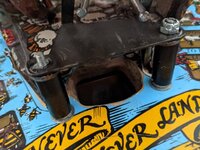
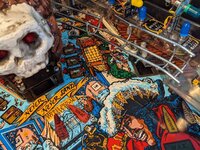
Check the rubbers
Most likely the machine rubbers will need replacing. People rarely replace the rubbers in my experience and the 'stock rubbers' on even modern machines don't last.
I've tried generic rubbers, Perfect play and Titan Rubbers. So far for me the stand out winner is Titan.
These were a are a pain to get in the UK until David at Retro Arcade Specialists started stocking them! (www.retroarcadesoecialists.co.uk). In my own opinion Titan rubbers are better than stock rubbers as they are made from Silicone which is longer lasting, look better and also grip the ball better than Perfect play. They are of course expensive so its not for everyone. I personally like buying colours which match to the theme of the machine.
Typical rubber sets are going to set you back about £50 - £100 dependant on the amount of rubbers in the game. You can use the Titan Pinball Kits database to see which rubbers you need to buy for your machine.
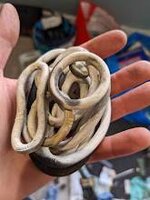
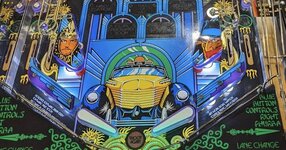
Check the Targets and Slingshot leaf switches:
Older machines will typically have a lot of wear on the Standup targets and Slingshots leafs. They get a beating over time.
Leafs switches range from about £5 - £15 to replace. You'll need to be confident with a soldering iron to replace these.
Targets:
Look at the condition of the targets are they broken or chipped? Is the sponge (if it has one) behind it completely worn?
Replacement targets again vary £9 - £20 again you'll need to be confident with a soldering iron to replace them.
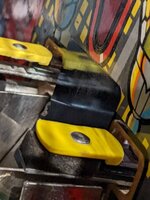
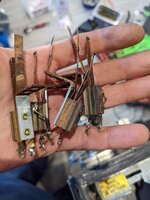
Replace the balls
If the machine hasn't had the balls replaced in the last 500 - 1000 plays just replace them. The steel balls bounce around the playfield often hitting metal on metal. They chip and those imperfections on the surface transfer to your playfield. Just buy new ones!
Dependant on your games you may have magnets in the game. These will have an impact on the balls of choice to purchase. My personal preference are polaris pinballs for games with Magnets and Ninja balls for games without. I haven't tried other brands so don't just choose this brand because I said so. Just make sure you replace the balls ASAP.
Again you can now get Ninja/Polaris pinballs from David at Retro Arcade Specialists.
Replacements range from £2 to £6 per ball.
Other playfield elements to note:
Modern machines such as Stern, JJP and Pinball Brothers don't coat the machines in the same way Bally/Williams used to. Neither do they likely use the same quality wood. I have 30+ year old machines which have ZERO dimpling while modern Machines like my Stranger Things had more dimples than a mine field.
Dimpling is just common and it doesn't affect the gameplay. You can minimise dimpling by using what is known as a 'Playfield protector' this is effectively a large sheet of PETG plastic that sits on top of your playfield. The result is a machine which should have zero dimpling but comes at the expense of having to take the top of the machine playfield parts off and also having to eventually replace it as they do scratch and dull over time.
The choice is yours to protect or not. Does it affect the value? I don't think so. Would a machine which has zero dimpling VS. one which has, be considered the better choice, all things being equal? Sure but it shouldn't sway your judgement when buying a machine.
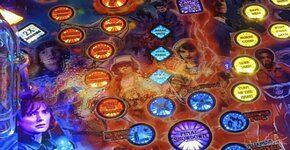
Check the batteries:
Older machines (Pre LCD screen machines basically) often have AA batteries in the back box. This is used to ensure the score and custom configuration (number of balls, time date, free play or credit etc.) are kept stored when the machine is turned off. People often forget to change them. Ask to check the back box and see if the batteries look OK. Look for corrosion damage. This can really be expensive to fix. If you see some knock another £200 there and then IF you still want the machine. If you don't want the repair bills or don't have the skills to replace/repair this yourself just walk away.
There are multiple solutions out there to avoid this issue. Some install a remote battery holder and sticky pad it to the side of the back box away from the components. Others solder a lithium cell chip/battery in its place. Others install an NVRAM chip. All require some technical knowledge and/or soldering skills to achieve so consider this in your budget if it just has the standard battery holder in place.
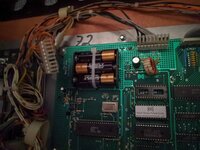
Check the Flippers
Check the flippers are they sluggish or unresponsive? Chances are they have either got bad stop coils and / or sleeves. These are a simple fix but a bit of a pain to replace. Factor in about £20 to resolve flipper issues if see any.
If a flipper is not returning back to its original position its either the coil stop has gone or the return spring has snapped. Here's an example.
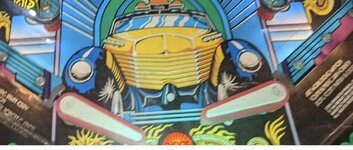
The same goes for any ejects in the machine. If they feel sluggish they probably need sleeves. I replace all my sleeves on every machine I purchase. They get ridges inside them over time and they are cheap to replace. Just annoyingly time consuming to take them out!
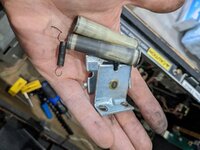
Cabinet and Backbox condition
Some argue this doesn't affect the price of the machine. In my opinion it does. Look for cabinet damage along the bottom of the cabinet and around the sides of the back box. Any gouges, cuts or scrapes? For me a pin is a furniture piece, you wouldn't have sofa with stuffing hanging outside the side would you?
Another thing to look for is cabinet fade. This is where the machine has been left in direct sunlight often bleaching the reds out of a machine.
You have two options to repair these. One if its an older pin which used a technique known as 'screening' you can touch up the machine using automotive paint but you'll need to have a steady hand! You'll also need wood filler, sanding block and sanding paper and a lot of patience.
I'll preface this that if the game looks good enough, leave it alone. You could end up making it worse!
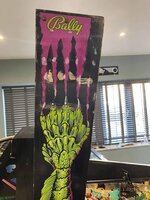
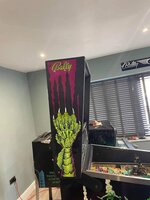
The other option is to take everything out of the machine, sand it down and apply new decals to the cabinet. Its an expensive process and not for everyone. You are looking between £180 - £200 for back box and cabinet artwork. Plus cost of either someone to fit them for you or you doing it yourself.
Its not for everyone so if you find a machine which has had decal work done, appreciate the fact that this is an expensive process which some charge hundreds and hundreds to carry out for you.
Speaking of which look for poor decal application as well.
Look for wrinkling, bulges and the like. This one was especially poor. It felt like a sponge when you applied pressure.
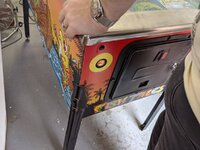
Look for the credit dot
Machines which have a mechanical (switch, mechanism or electrical) fault will often produce a small dot next to the credit word on the Dot Matrix Display. (On free play it will be after the word free play. If you see this ask to open the coin door and enter the diagnostics menu. It should immediately chime with a 'TEST REPORT ERROR' and proceed to tell you what's wrong. It could be simply a bad switch (£5- £15), no date or time set or a bad opto. Or it could be hiding worse. Factor this in when making your final offer and whether you want the hassle of troubleshooting and resolving the errors produced.
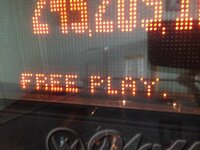
Check for Rust/Corrosion
Check around the feet (known as leg levelers) for rust. This will give away any sign that the machine has been stored in a poor condition (highly damp area).
Rust really if you main enemy here and it can cause so much damage under the playfield. You may end up spending hundreds treating/replacing parts which have become corroded. If you see rust on the legs, ask the person to lift the playfield so you can inspect underneath...
You may see an unwelcome surprise.
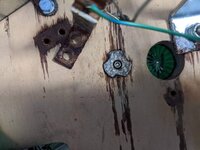
Replacement Leg Levelers are about £1.30 each. Legs them selves are about £100.
Treat/Replace corrosion where you see it. Don't let it fester!
Rust/Corrosion can also make its way into the backbox and other components under the playfield. Games can exhibit real issues if corrosion hit the connectors. Its likely you won't have the opportunity to check headers during a prospective purchase but spend time checking over the headers. I recently spent MONTHS diagnosing an issue with my BSD thinking first it was my wiring, then my Opto board. Only to find a header in the backbox had corrosion and was very sporadically causing a break tripping Opto's inadvertently. If you see an aftermarket MPU board in the backbox ask if there was a history of battery damage. Its a good to understand the history of the machine where possible as it will help you diagnose issues that may be related.
Replacement plastics/Ramps
Are any parts of the machine broken such as the ramps or plastics? Be warned replacement ramps could set you back hundreds to replace. Plastic sets up to £200 for a full set with £10 - £30 per piece!
Factor this in when making your final offer.
Be warned some ramps are not in production and have effectively become unobtainable. This is true of at time of writing, Johnny Mneomic which at present you cannot source the left or right ramp. Do some homework on your pin before you part with money.
Transporting the machine
If this is your first purchase I would recommend Martin from Retro Logistics (you can google his details they will come up). He charges £110 (£125 for Scotland) for a pickup and delivery to your address. This will take a lot of the hassle factor away from you but just be sure the seller knows they need to pack the machine adequately for travel. You don't want any surprises when it arrives at your door!
If you plan to do the pick up yourself consider the following:
Get a scissor lift something that's rated up to 150KG. I've successfully lifted a JJP GnR LE with easy on a 150KG scissor lift when the machine itself weighs in at 147KG! Most machines are about 120KG and dead lifting these to put the legs on is daunting and dangerous to your back. Buy a scissor lift!
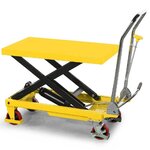
Your other choice is a sack trolley but this won't help you get the legs off and on.
Its great for getting the pin into the Van upright however.
I got my Scissor lift for £150 but they seem to go for around £300 now. The Sack Trolley is only £115.
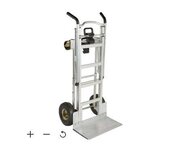
Get reinforced cardboard for the edges and shrink wrap to protect and cushion the machine.
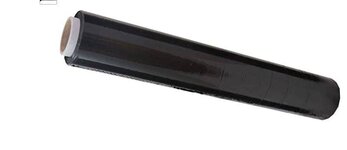
*** JUST REMEMBER WHEN YOU TRANSPORT THE MACHINE TAKE THE BALLS OUT FIRST! ***
Tools:
All machines except for machines such as Pinball Brothers use IMPERIAL tooling. Pinball Brothers uses Metric.
I recommend for starters to buy yourself a Wickes 46 Piece Ratchet Screwdriver Set. The only down fall is that its not magnetic but on the plus side it has all the imperial AND metric sizes you need for the various different nuts and screws that each machine uses. Its served me very well.
Its also a bargain at £13.50
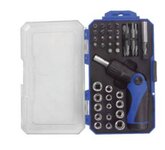
For the leg bolts and back box I bought this ratchet especially. I only like it because it doesn't damage the bolt head and doesn't scrape the legs. This is especially good if your legs are powder coated and you don't want to damage them. Its not perfect as the head can pop off easily due to its design (pins) but I still use it over my standard hex head.
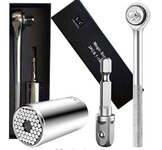
On some machines such as JJP and Data East you'll need to use Hex Keys to remove the back box hinge and lower the back box.
I recommend the Presch Hex Key Set HX 30pcs set as its got both imperial and metric
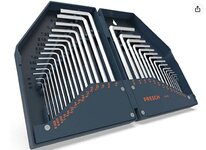
How to clean/maintain your machine:
Every machine I've purchased has needed cleaning, some jobs have been small other jobs have been massive. I treat machines like I treat my car. A clean machine is a happy machine.
Things to avoid using on your new purchase:
WD40
many parts do not need lubrication and only a VERY FEW items such as cog based mechs ever need lubricant, most machines are designed to 'run dry' if something isn't running right (Flippers for instance) don't coat them in grease!
its likely they just need replacement coils/sleeves.
Abrasive Cleaners (no furniture polish!)
Get the following to clean your machine!
Novus
You basically need Novus 1 and 2. You don't need 3.
1 is used for polishing plastics, 2 is used for scratches and cleanup of your playfield its VERY mildly abrasive and does a great job of removing ball 'grime' from the playfield. You can take a machine looking from this:
*Some argue Novus 2 is too abrasive and will eventually wear the playfield. My recommendation would be this. If the machine looks like its just come out of the Victorian age. Use Novus 2. For standard ball trail grime maintenance use a foam cleaner.*
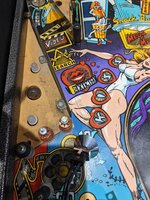
To this:
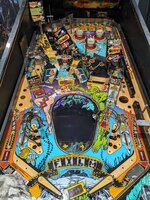
Buy the novus polish mates they are disposable soft cloths which work great to remove the rubbish and you can just ditch them when you are done.
Use Novus 1 on the plastics to bring the shines back to them.
AutoGlym Fast Glass
It seems unfortunately a lot of people don't realise that the modern machines (limited editions typically) come with treated glass to reduce reflections on the playfield. When cleaning the glass you should either just use water or specific cleaners that are designed to clean treated glass. My favourite is fast glass. Here's a before and after:
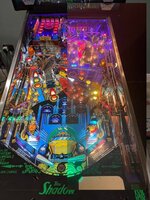
This is what happens when you use abrasive cleaner on treated glass.
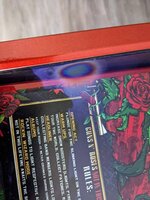
AutoGlym Metal polish
This stuff is great at making your chrome elements shine.
Here's some before and after:
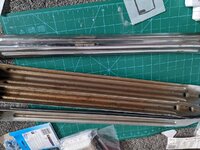
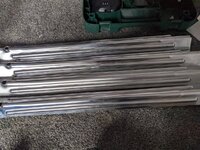
AutoGlym Magma and Evaporust
This stuff stinks (as in smell) but my God is it good at lifting off rust. I recommend using it away from the machine where possible in containers where you can treat the rust. This and evaporust are great at removing rust from bolts, nuts and screws etc.
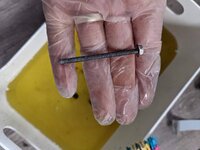
GERLITZ CARNAUBA WAX GUITAR POLISH
This stuff is great for the playfield give this stuff a once over after you've cleaned with Novus 2 to bring a real shine to the machine playfield. Be it will make the game incredibly hard initially as the ball will travel smoother (faster) across the playfield).
Tips for buying new!
Buying new won't mean you won't get your hands dirty!
Check the service bulletins for your respective machine and ensure you follow owners threads either on here or on pinside for advice and tips on resolving any manufacturer issues. These could be adding metal protectors (Cliffy's) to the machine or adjusting diverters or ramps to resolve play issues.
Again as before keep the playfield clean and replace those rubbers/balls. Protect your machine, treat it as an investment!
Hopefully you find this information useful.
Good luck and enjoy some pinball!
Cheers,
Scott
So I've been in this hobby about a year and within that time I've had:
- Star Trek Premium
- Black Knight Swords of Rage Premium
- Stranger Things Pro
- Hook
- Teenage Mutant Ninja Turtles Pro
- Alien SV (Pinball Brothers)
- Bram Stokers Dracula
- The Shadow
- Creature From the Black Lagoon
- Jurassic Park Limited Edition (Stern)
- Gun's N' Roses LE (JJP)
I wanted to Share with people the knowledge and tips I've learnt along the way across fixing and restoring the machines from all the different brands of machines I've owned.
Purchasing a used machine:
The forum has a for sale section, its a good place to find machines but also put up wanted AD's for machines you are after.
There are sellers on here which are deemed trust worthy, build connections and relations with people this way when one comes up for sale you don't need to hesitate on who its from and just buy with confidence.
If you and others don't recognise the seller, where possible try and go and see the machine before putting money down for one. Its an expensive purchase and you could end up sinking £100's-£1000's more just to fix what lies beneath.
Locking in a purchase in my experience is usually done via a deposit. Most people operate on Bank Transfers or PayPal Friends and Family. I've had deposits accepted from £100 - £500 typically dependant on the value of the machine and the person.
Final purchase I've usually made in person either again by Bank Transfer or 'Cash on the glass' I'll be honest I hate holding large sums of cash and personally prefer bank transfers. Use whatever works for you and the person selling.
What to look for when buying used:
Check for wear:
When inspecting any machine take time to check the playfield for wear. Typical wear spots are by holes in the playfield where the ball goes into. These can be referred to as 'Scoops'. Older machines such as machines made by Data East, Sega, Bally and Williams often did not put metal protectors around these area's.
It doesn't mean the machine is not fixable!
You can purchase what are known as 'Cliffy's' to protect the machine and also hide the damage. The term 'Cliffy' is used as Cliff Reiner the original creator of metal protectors for machines developed a line of metal protectors to fit over specific area's of machines prone to wear. Now regardless who makes them (copies them) people refer to them as 'Cliffy's'.
If the machine doesn't have them and you notice wear, factor these into your budget when purchasing a machine.
I also recommend buying these when buying new! (see What to consider when buying new).


Check the rubbers
Most likely the machine rubbers will need replacing. People rarely replace the rubbers in my experience and the 'stock rubbers' on even modern machines don't last.
I've tried generic rubbers, Perfect play and Titan Rubbers. So far for me the stand out winner is Titan.
These were a are a pain to get in the UK until David at Retro Arcade Specialists started stocking them! (www.retroarcadesoecialists.co.uk). In my own opinion Titan rubbers are better than stock rubbers as they are made from Silicone which is longer lasting, look better and also grip the ball better than Perfect play. They are of course expensive so its not for everyone. I personally like buying colours which match to the theme of the machine.
Typical rubber sets are going to set you back about £50 - £100 dependant on the amount of rubbers in the game. You can use the Titan Pinball Kits database to see which rubbers you need to buy for your machine.


Check the Targets and Slingshot leaf switches:
Older machines will typically have a lot of wear on the Standup targets and Slingshots leafs. They get a beating over time.
Leafs switches range from about £5 - £15 to replace. You'll need to be confident with a soldering iron to replace these.
Targets:
Look at the condition of the targets are they broken or chipped? Is the sponge (if it has one) behind it completely worn?
Replacement targets again vary £9 - £20 again you'll need to be confident with a soldering iron to replace them.


Replace the balls
If the machine hasn't had the balls replaced in the last 500 - 1000 plays just replace them. The steel balls bounce around the playfield often hitting metal on metal. They chip and those imperfections on the surface transfer to your playfield. Just buy new ones!
Dependant on your games you may have magnets in the game. These will have an impact on the balls of choice to purchase. My personal preference are polaris pinballs for games with Magnets and Ninja balls for games without. I haven't tried other brands so don't just choose this brand because I said so. Just make sure you replace the balls ASAP.
Again you can now get Ninja/Polaris pinballs from David at Retro Arcade Specialists.
Replacements range from £2 to £6 per ball.
Other playfield elements to note:
Modern machines such as Stern, JJP and Pinball Brothers don't coat the machines in the same way Bally/Williams used to. Neither do they likely use the same quality wood. I have 30+ year old machines which have ZERO dimpling while modern Machines like my Stranger Things had more dimples than a mine field.
Dimpling is just common and it doesn't affect the gameplay. You can minimise dimpling by using what is known as a 'Playfield protector' this is effectively a large sheet of PETG plastic that sits on top of your playfield. The result is a machine which should have zero dimpling but comes at the expense of having to take the top of the machine playfield parts off and also having to eventually replace it as they do scratch and dull over time.
The choice is yours to protect or not. Does it affect the value? I don't think so. Would a machine which has zero dimpling VS. one which has, be considered the better choice, all things being equal? Sure but it shouldn't sway your judgement when buying a machine.

Check the batteries:
Older machines (Pre LCD screen machines basically) often have AA batteries in the back box. This is used to ensure the score and custom configuration (number of balls, time date, free play or credit etc.) are kept stored when the machine is turned off. People often forget to change them. Ask to check the back box and see if the batteries look OK. Look for corrosion damage. This can really be expensive to fix. If you see some knock another £200 there and then IF you still want the machine. If you don't want the repair bills or don't have the skills to replace/repair this yourself just walk away.
There are multiple solutions out there to avoid this issue. Some install a remote battery holder and sticky pad it to the side of the back box away from the components. Others solder a lithium cell chip/battery in its place. Others install an NVRAM chip. All require some technical knowledge and/or soldering skills to achieve so consider this in your budget if it just has the standard battery holder in place.

Check the Flippers
Check the flippers are they sluggish or unresponsive? Chances are they have either got bad stop coils and / or sleeves. These are a simple fix but a bit of a pain to replace. Factor in about £20 to resolve flipper issues if see any.
If a flipper is not returning back to its original position its either the coil stop has gone or the return spring has snapped. Here's an example.

The same goes for any ejects in the machine. If they feel sluggish they probably need sleeves. I replace all my sleeves on every machine I purchase. They get ridges inside them over time and they are cheap to replace. Just annoyingly time consuming to take them out!

Cabinet and Backbox condition
Some argue this doesn't affect the price of the machine. In my opinion it does. Look for cabinet damage along the bottom of the cabinet and around the sides of the back box. Any gouges, cuts or scrapes? For me a pin is a furniture piece, you wouldn't have sofa with stuffing hanging outside the side would you?
Another thing to look for is cabinet fade. This is where the machine has been left in direct sunlight often bleaching the reds out of a machine.
You have two options to repair these. One if its an older pin which used a technique known as 'screening' you can touch up the machine using automotive paint but you'll need to have a steady hand! You'll also need wood filler, sanding block and sanding paper and a lot of patience.
I'll preface this that if the game looks good enough, leave it alone. You could end up making it worse!


The other option is to take everything out of the machine, sand it down and apply new decals to the cabinet. Its an expensive process and not for everyone. You are looking between £180 - £200 for back box and cabinet artwork. Plus cost of either someone to fit them for you or you doing it yourself.
Its not for everyone so if you find a machine which has had decal work done, appreciate the fact that this is an expensive process which some charge hundreds and hundreds to carry out for you.
Speaking of which look for poor decal application as well.
Look for wrinkling, bulges and the like. This one was especially poor. It felt like a sponge when you applied pressure.

Look for the credit dot
Machines which have a mechanical (switch, mechanism or electrical) fault will often produce a small dot next to the credit word on the Dot Matrix Display. (On free play it will be after the word free play. If you see this ask to open the coin door and enter the diagnostics menu. It should immediately chime with a 'TEST REPORT ERROR' and proceed to tell you what's wrong. It could be simply a bad switch (£5- £15), no date or time set or a bad opto. Or it could be hiding worse. Factor this in when making your final offer and whether you want the hassle of troubleshooting and resolving the errors produced.

Check for Rust/Corrosion
Check around the feet (known as leg levelers) for rust. This will give away any sign that the machine has been stored in a poor condition (highly damp area).
Rust really if you main enemy here and it can cause so much damage under the playfield. You may end up spending hundreds treating/replacing parts which have become corroded. If you see rust on the legs, ask the person to lift the playfield so you can inspect underneath...
You may see an unwelcome surprise.

Replacement Leg Levelers are about £1.30 each. Legs them selves are about £100.
Treat/Replace corrosion where you see it. Don't let it fester!
Rust/Corrosion can also make its way into the backbox and other components under the playfield. Games can exhibit real issues if corrosion hit the connectors. Its likely you won't have the opportunity to check headers during a prospective purchase but spend time checking over the headers. I recently spent MONTHS diagnosing an issue with my BSD thinking first it was my wiring, then my Opto board. Only to find a header in the backbox had corrosion and was very sporadically causing a break tripping Opto's inadvertently. If you see an aftermarket MPU board in the backbox ask if there was a history of battery damage. Its a good to understand the history of the machine where possible as it will help you diagnose issues that may be related.
Replacement plastics/Ramps
Are any parts of the machine broken such as the ramps or plastics? Be warned replacement ramps could set you back hundreds to replace. Plastic sets up to £200 for a full set with £10 - £30 per piece!
Factor this in when making your final offer.
Be warned some ramps are not in production and have effectively become unobtainable. This is true of at time of writing, Johnny Mneomic which at present you cannot source the left or right ramp. Do some homework on your pin before you part with money.
Transporting the machine
If this is your first purchase I would recommend Martin from Retro Logistics (you can google his details they will come up). He charges £110 (£125 for Scotland) for a pickup and delivery to your address. This will take a lot of the hassle factor away from you but just be sure the seller knows they need to pack the machine adequately for travel. You don't want any surprises when it arrives at your door!
If you plan to do the pick up yourself consider the following:
Get a scissor lift something that's rated up to 150KG. I've successfully lifted a JJP GnR LE with easy on a 150KG scissor lift when the machine itself weighs in at 147KG! Most machines are about 120KG and dead lifting these to put the legs on is daunting and dangerous to your back. Buy a scissor lift!

Your other choice is a sack trolley but this won't help you get the legs off and on.
Its great for getting the pin into the Van upright however.
I got my Scissor lift for £150 but they seem to go for around £300 now. The Sack Trolley is only £115.

Get reinforced cardboard for the edges and shrink wrap to protect and cushion the machine.

*** JUST REMEMBER WHEN YOU TRANSPORT THE MACHINE TAKE THE BALLS OUT FIRST! ***
Tools:
All machines except for machines such as Pinball Brothers use IMPERIAL tooling. Pinball Brothers uses Metric.
I recommend for starters to buy yourself a Wickes 46 Piece Ratchet Screwdriver Set. The only down fall is that its not magnetic but on the plus side it has all the imperial AND metric sizes you need for the various different nuts and screws that each machine uses. Its served me very well.
Its also a bargain at £13.50

For the leg bolts and back box I bought this ratchet especially. I only like it because it doesn't damage the bolt head and doesn't scrape the legs. This is especially good if your legs are powder coated and you don't want to damage them. Its not perfect as the head can pop off easily due to its design (pins) but I still use it over my standard hex head.

On some machines such as JJP and Data East you'll need to use Hex Keys to remove the back box hinge and lower the back box.
I recommend the Presch Hex Key Set HX 30pcs set as its got both imperial and metric

How to clean/maintain your machine:
Every machine I've purchased has needed cleaning, some jobs have been small other jobs have been massive. I treat machines like I treat my car. A clean machine is a happy machine.
Things to avoid using on your new purchase:
WD40
many parts do not need lubrication and only a VERY FEW items such as cog based mechs ever need lubricant, most machines are designed to 'run dry' if something isn't running right (Flippers for instance) don't coat them in grease!
its likely they just need replacement coils/sleeves.
Abrasive Cleaners (no furniture polish!)
Get the following to clean your machine!
Novus
You basically need Novus 1 and 2. You don't need 3.
1 is used for polishing plastics, 2 is used for scratches and cleanup of your playfield its VERY mildly abrasive and does a great job of removing ball 'grime' from the playfield. You can take a machine looking from this:
*Some argue Novus 2 is too abrasive and will eventually wear the playfield. My recommendation would be this. If the machine looks like its just come out of the Victorian age. Use Novus 2. For standard ball trail grime maintenance use a foam cleaner.*

To this:

Buy the novus polish mates they are disposable soft cloths which work great to remove the rubbish and you can just ditch them when you are done.
Use Novus 1 on the plastics to bring the shines back to them.
AutoGlym Fast Glass
It seems unfortunately a lot of people don't realise that the modern machines (limited editions typically) come with treated glass to reduce reflections on the playfield. When cleaning the glass you should either just use water or specific cleaners that are designed to clean treated glass. My favourite is fast glass. Here's a before and after:

This is what happens when you use abrasive cleaner on treated glass.

AutoGlym Metal polish
This stuff is great at making your chrome elements shine.
Here's some before and after:


AutoGlym Magma and Evaporust
This stuff stinks (as in smell) but my God is it good at lifting off rust. I recommend using it away from the machine where possible in containers where you can treat the rust. This and evaporust are great at removing rust from bolts, nuts and screws etc.

GERLITZ CARNAUBA WAX GUITAR POLISH
This stuff is great for the playfield give this stuff a once over after you've cleaned with Novus 2 to bring a real shine to the machine playfield. Be it will make the game incredibly hard initially as the ball will travel smoother (faster) across the playfield).
Tips for buying new!
Buying new won't mean you won't get your hands dirty!
Check the service bulletins for your respective machine and ensure you follow owners threads either on here or on pinside for advice and tips on resolving any manufacturer issues. These could be adding metal protectors (Cliffy's) to the machine or adjusting diverters or ramps to resolve play issues.
Again as before keep the playfield clean and replace those rubbers/balls. Protect your machine, treat it as an investment!
Hopefully you find this information useful.
Good luck and enjoy some pinball!
Cheers,
Scott
Last edited:
